
|
|
The Golden Triangle
Tour with Dussehra Festival
|
(14
Days / 13 Nights)
(Delhi-Jaipur-Pachewar-Kota-Ranthambore-Fatehpur Sikri-Agra-Delhi)
(to view the route of this tour on a Map please click
here)
|

Welcome |
|
|
|
|
|
|
|
|
|
|
|
|
|
|
|
|
|
|
|
|
|
|
|
|
|
|
|
|
|
|
|
|
|
|
|
|
|
|
|
|
|
|
|
|
|
|
|
|
|
 |
|
Thee festival of Dussehra, also known as Vijayadashmi, is one
of the fascinating festivals of India and is celebrated with
joy and enthusiasm. According to the great Hindu scripture,
the Ramayana, Lord Rama performed chandi-puja (holy prayer).
This was carried out in order to invoke the blessings of Durga
Maa for the killing of Ravana, the ten-headed demon king of
Sri Lanka who had abducted Seeta, wife of Lord Rama.
Durga Maa divulged the secret to Rama on how he could slay
the great Ravana. Hence upon vanquishing the demon Ravana,
Lord Rama with Sita and younger brother Laxmana, returned
victorious to his kingdom of Ayodhya on the day which is
called 'Diwali'. Revelers across northern India re-enact the
legend at sundown in a performance called the Ramlila,
featuring actors dressed as Rama shooting flaming arrows at
effigies stuffed with firecrackers.
Dassera day is considered a most auspicious day. It is a
time-honored belief that if any new venture is started on this
day, it is bound to be successful. Hence, all the undertakings
be it laying-in of foundation of a new building, opening of a
new commercial establishment or even initiating a child into
the world of learning- are started on this day. Also on this
day implements of agriculture, manufacturer's machines, the
intellectuals pens, the household articles, the children's
school books are placed before the idol of Durga and
worshiped.
|
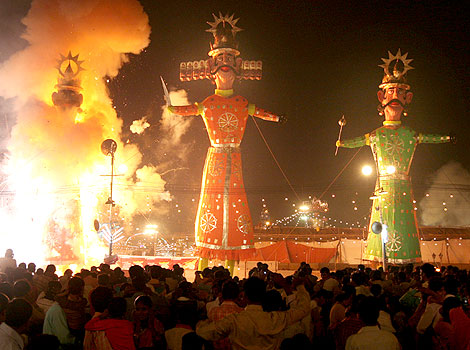 |
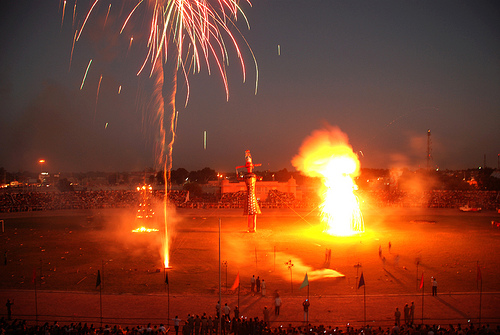 |
|
Dussehra Festival Kota
On tour to Rajasthan don't skip a visit to Kota. Kota has once
served as the integral part of the former Rajput kingdom of
Bundi. In 17th century it was formed into a distinct princely
state. Today, it is widely known for its imposing palaces,
landscaped gardens and numerous attractive monuments. Located
on the banks of Chambal River and drained by its affluents,
Kota is a magnificent scenic spot to visit. However, apart
from historical importance and picture-perfect beauty, Kota
also reigns supreme among tourists for holding gala
celebrations for Dussehra Festival. The Dussehra Festival,
Kota can be touted among the major attractions of the town.
During the Dussehra Festival in Kota a very
vibrant and colorful mela or fair is organized.
This festival
is usually held every year in the Hindu month of Ashvin that
begins from September and ends in October.
This festival has a mythical association. According to the
legend, this event is
held to celebrate the triumph
|
|
of Lord Rama over the Demon King
Ravana. This most fiery fight between demon and god continued
for 10 days in which evil had to face defeat at last.
The very catchy feature of the Dussehra
Festival, Kota is the theatrical representation of this
encounter. In this dramatic enactment both children and elders
take part with great fervor and enthusiasm. In the whole drama
the portion that attracts children to the fullest extent is
the role of the Vanar Senas or the monkey forces led by the
monkey God Hanuman. The drama is personified to such an extent
that audience starts singing slogans in praise of Lord Rama.
However the climax of the drama comes with setting fire on the
gigantic effigies of the defeated 10 headed Ravana along with
his brother Kumbhkarana and his son Meghnath. The effigies are
basically built of paper and bamboo.
These are packed with crackers which actually help in setting
fire.
|
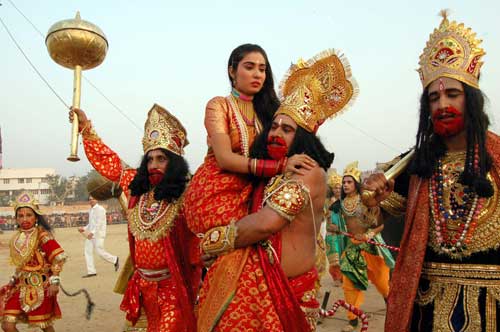 |
|
Once the effigies of the demons
are burnt people change their
course
of activities and bask in various
other festivities during Kota's Dussehra Festival. Of the
numerous celebrations, cattle fair in Kota is the
must-witnessed sight.
|
|
History
The town of Kota was once the part of the erstwhile Rajput
kingdom of Bundi. It became a separate princely state in the
17th century. Apart from the several monuments that reflect
the erstwhile glory of the town, Kota is also known for its
palaces and gardens. Kota is located in the southern part of
the state of Rajasthan, in the northwestern part of India. It
is located on the eastern bank of Chambal River and is drained
by its tributaries. Kota is on a high sloping tableland
forming a part of the Malwa Plateau. The Mokandarra hills run
from southeast to northwest axis of the town. It is 36 km from
Bundi. Summers are quite hot (April–June) while winters are
cool (October–February). It experiences scant rainfall between
June and August.
The history of Kota is linked with the history of Bundi.
Both Bundi and Kota came under the rule of the Chauhans in the 12th
century. The descendents of the Chauhans set up their capital
at
Bundi and ruled from here. While Bundi
was the capital,
Kota formed the land granted to the eldest son of the ruler.
This arrangement continued until 1624. In 1624, Emperor Jahangir, the great Mughal ruler, partitioned Bundi and made
Kota an independent state. Rao Madho Singh, son of the ruler
of Bundi, ascended the throne of Kota. It became a part of the
British Empire in 1818 and later became a part of the Indian
state of Rajasthan, when it gained independence in 1947.
Kota Dussehra
Location: Kota,
Rajasthan.
Significance:
To celebrate Ram's victory over Ravana.
Time of Celebration:
For a fortnight on the auspicious occasion of Dussehra, which
usually falls in October.
Dussehra is the beloved festival that is celebrated almost all over
India but Dussehra in Kota certainly sets it apart with 75 feet tall
effigies of the demons Ravana, Kumbhakarana and Meghnath that are
burnt here on Dussehra day. Villagers dress themselves in colorful
dresses and offer prayers to Lord Rama.
There is a dazzling procession that mesmerizes the onlookers
that come here from the surrounding villages and
provide a ripe opportunity
for the traders to display their |
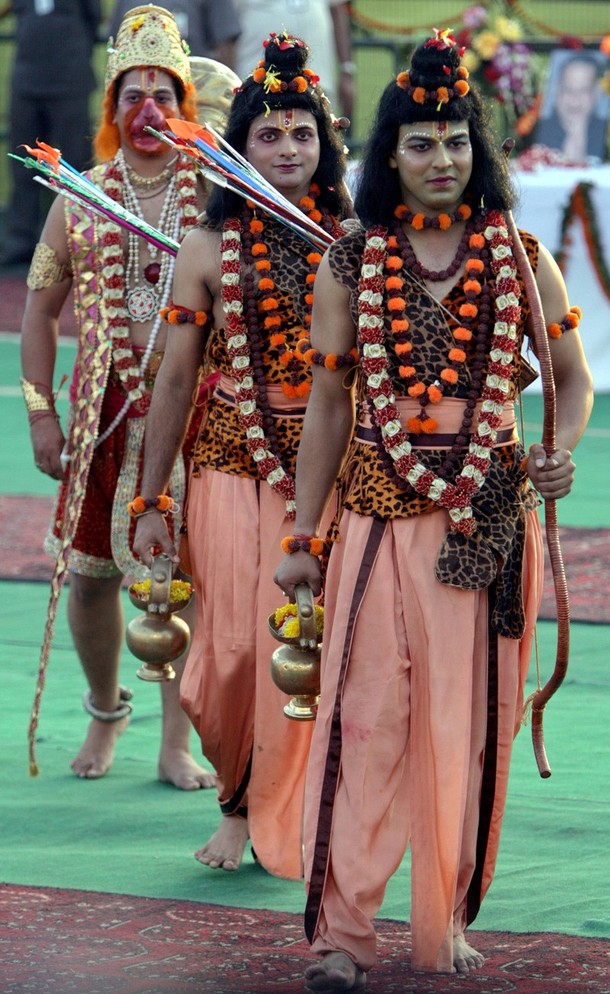 |
|
|
|
wares.
Cultural Programmes are organized and one
can see the scintillating performances by the prominent artistes who
come here from all over the country.
Famous for:
Kota Barrage, Jag Mandir, Haveli of Devtaji, Chambal Garden,
Maharaja Madho Singh Museum etc.
Dussehra Festival:
22nd October, 2015
Dussehra Festival - Kota , Rajasthan (October) coming year
11th October, 2016
|
|
Day 01. Flight
to India (Delhi)
Around midnight arrival in
Delhi. The cosmopolitan city and capital Delhi is the main gateway for
travelers. You are met by an Indo Vacations representative and
transferred to the hotel.
Day 02. Old - New Delhi
This morning is at leisure. Afternoon sightseeing in
Old Delhi. We take a Rickshaw Ride parallel to the
Red Fort through the old city and famous
Silk Road and Silver Bazaar. Sightseeing of Old Delhi includes "Rajghat"
, the place where Mahatma Gandhi was cremated and
Jama Masjid,
the great mosque of old Delhi. Today we also visit the famous “Humayun
Tomb” which
is the first substantial example of Mughal architecture in India and
“Qutub
Minar” which is 71 meter high
and was constructed in 1199. Before we proceed to the Hotel we have
a drive through New Delhi where we see the
India Gate,
Government Buildings and Embassies.
|
 |
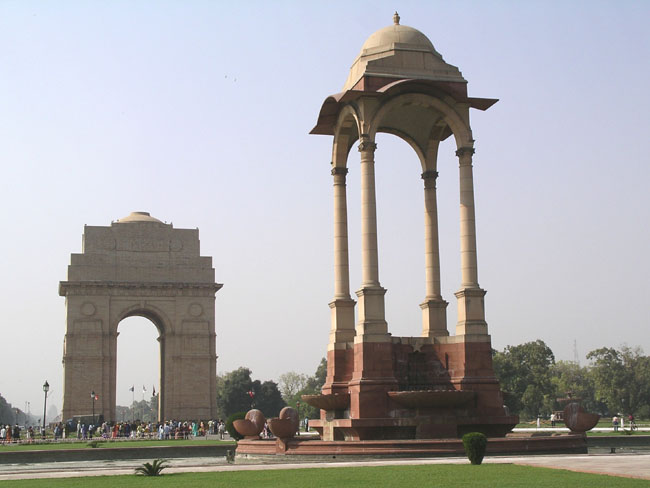 |
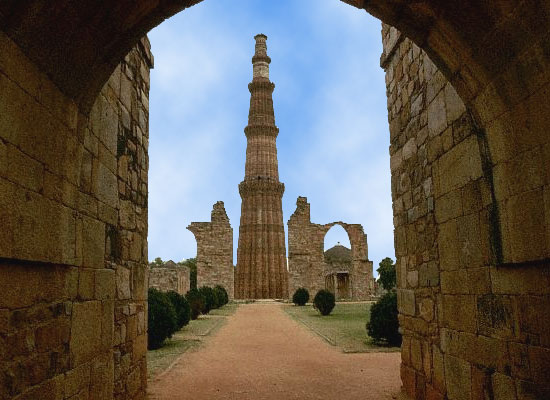 |
 |
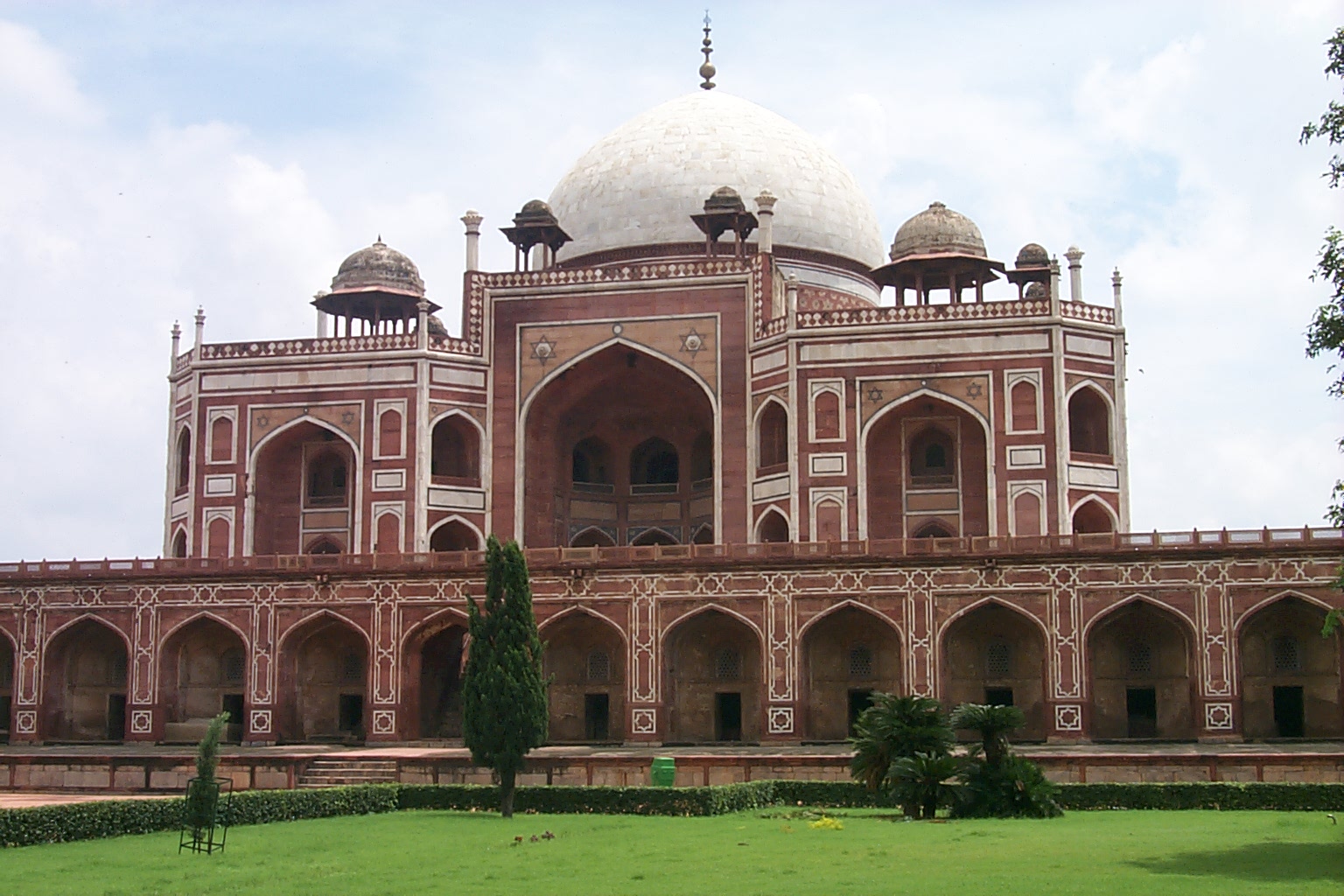 |
|
Day 03. Delhi - Jaipur (about
270 km / 5-6 hours)
Today we drive to the Pink
City,
Jaipur. This city owes its name, foundations and careful planning to the
great warrior and astronomer, Maharaja Sawai Jai Singh II. Jaipur is the capital
of Rajasthan and famous for its handicrafts and precious and semiprecious
stones. In the afternoon we visit
the
City palace which is still the formal residence of the royal family, built
in a blend of the Rajasthani and Mughal
architecture. In the museum of the city
palace we visit the private collection of the Jaipur Maharajas. We continue to
Jantar Mantar, a stone observatory, the
largest of Jai Singh's five remarkable observatories. Its complex
instruments reveals us the secrets of medieval Indian astronomy.
|
|
Day 04. Jaipur
After breakfast we drive to
the ancient capital of
Amber, laying 11 km. away from Jaipur. Amber was the
ancient capital of Kachhawaha dynasty for 6 centuries before it was moved to
newly created Jaipur. We will ascend to the Palace Fortress on the back of an
Elephant. Enroute to Amber we visit the
Hawa Mahal (Palace of the Winds), built
in 1799 AD, it contains 953 small casements with each having its own balcony.
The windows enabled cool air to circulate and the ladies to watch processions
below without being seen. In the afternoon we have a
walk through the colourful Bazaar of Jaipur and visit a factory to see the
famous block printing work being done since centuries in Jaipur.
In the evening we drive
through the new city of Jaipur and visit “Laxmi Narayan Mandir”, a Hindu temple
made out of white marble. We might have an opportunity here to observe a prayer
ceremony. Today we have dinner with a presentation of Indian music and
dance.
|
 |
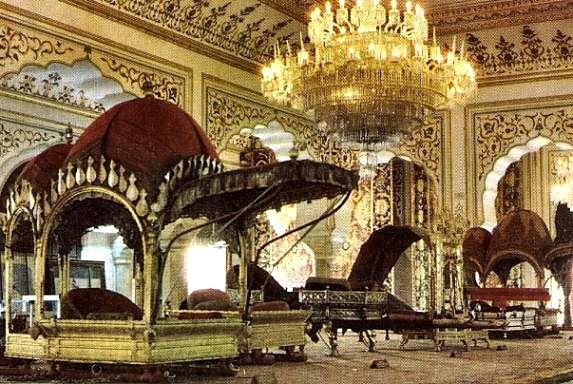 |
 |
 |
|
Day 05. Jaipur - Pachewar (about 105 kms
/ 2 hours)
Today we leave Jaipur
drive to Pachewar. Pachewar is a mute yet vibrant village situated 90 kms.
away from Jaipur, the capital of Rajasthan, India. The 300 years old
picturesque fort of Pachewar has now been converted into a luxurious
heritage hotel with all modern amenities, where one can witness great
traditions of royal hospitality. It is located at a distance of 105 kms.
from Jaipur Airport and 90 kms. from Railway Station. Built in Indo-European
style, Hotel Pachewar Garh is undoubtedly one of the most popular Heritage
Hotels in Rajasthan. The fort houses intricate balconies and spacious
apartments adorned with elegant antique frescoes.
|
 |
Day 06 to Day 08: Kota -
Pachewar - Kota (about 145 km / 3 hours)
Today we drive to
Kota. The town of
Kota was once the part of the erstwhile Rajput kingdom of
Bundi. In Kota we
will visit the city fort and palace, this type of fort-palace complex is one
of the largest to be found in the state of Rajasthan.
Dussehra is also known as Vijaya
Dasami, because of the victory of Ram over Ravana. On this day in Satya Yug,
Ram (the eighth incarnation of Lord Vishnu), killed the great demon and king
of Lanka, Ravana. Puranas also opined that in this day warrior Goddess Durga
defeated and killed the buffalo demon Mahishasura. |
Day 09. Kota -
Ranthambore (about 135 kms
/ 3 hours)
Today after the breakfast we leave for
Ranthambore. Ranthambore is known for the
world famous Ranthambore National park. After a break and refreshment at our
hotel in Ranthambore we will explore the
Ranthambore National park on a Jeep.
Ranthambore National Park is surrounded by the Vindhyas and the Aravali
mountains and covers an area of 392 square km. The Tiger remains the biggest
attraction of the Ranthambore National Park.
|
Day 10. Ranthambore
In the early morning we again explore the park on
canter. If we are lucky
enough we might have an audience with the tiger which are numerous in the
park.
|
 |
 |
|
Day 11. Ranthambore - Fatehpur Sikri
- Agra (about 250 km / 5-6 hours)
In the early morning we again explore the park on jeeps. After the Jeep
Safari and perhaps with the memories of our encounter with tiger we leave
Rajasthan, the biggest state in India and drive through a series of fields,
small towns and villages to Agra. Enroute we make a stop and visit
Fatehpur Sikri, which
was once an imperial capital frozen in time, constructed by Akbar the Great
in the 16th century. This wonderful city constructed by red sand stones was
abandoned as abruptly as it had been built. It has been generally stated
that it was due to failing in the water supply. Late evening arrival in
Agra. Rest of the day at leisure.
Day 12. Agra
We start today our sightseeing by a visit to the
Agra Fort, built by
three of the greatest Mughal emperors. The
construction of this massive structure began in 1565 under Akbar's reign and
continued till the time of his grandson's reign, Shah Jahan who built the
impressive imperial quarters and mosque. After the visit of Agra Fort we
proceed to visit the most beautiful monument of India, the
Taj Mahal, an
enduring monument to love, with a continually fulfilling beauty. It was
built by the Mughal Emperor Shah Jahan between 1631-52, as a tomb and
memorial to his beloved wife Mumtaz Mahal (Jewel of the Palace), who died at
the age of 39 giving birth to her 14th child. We spend enough time at Taj
Mahal to take this impressive memory home. After the visit of Taj Mahal we
have a look at the famous fine marble inlay work which is still being done
in Agra by the descendants of the families of builders and artists of the
Taj Mahal.
|
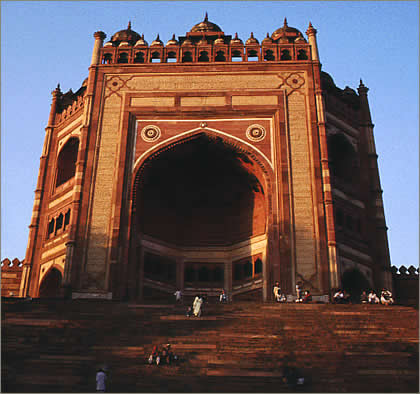 |
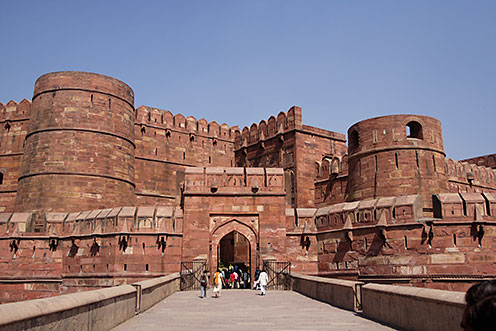 |
|
 |
|
Day 13. Agra -
Delhi
(about 200
km
/ 4 hours)
In the morning after having breakfast we drive to Delhi. Arrival in Delhi in
the afternoon. The rest of the day at leisure. (opportunity for the last
shopping or enjoy a massage in the Hotel)
Day 14.
Flight to Home
Around midnight flight to home destination.
|
|
Tour
Reservation
To get more
information or to book this tour please submit the
Query Form or send us an
e-mail !
Your
booking will be activated only after we get a reconfirmation from
your side.
About
Hotels:
We
provide you the accommodation as per your budget mentioned above in
the table of hotels category for any of the booked tour. Hotels
provided by us are from budget to luxury class hotels. Luxury hotels are
all five stars or of above standard. Deluxe would be a combination of
3 and 4 star Hotels and standard would be a combination of 2 and 3
star or similar hotels. The criteria
for selecting hotels by us remains the best value of your money. We
also provide you wherever possible accommodation in heritage hotels.
Heritage Hotels are old Palaces, Forts and Grand mansions of Maharajas
which have been later renovated and converted into Hotels. Rooms are
decorated all individually. Rooms are comfortable, romantic and
present the flair of olden Maharaja days.
|
|
Up
|
|
Proposed
Hotels |
Nights |
Indo Vacations – Inclusions:
 Accommodation in a double room with shower /bath &
WC in the hotels as indicated.
Accommodation in a double room with shower /bath &
WC in the hotels as indicated.
 Half board (breakfast and dinner
in the booked Hotels).
Half board (breakfast and dinner
in the booked Hotels).
 Rickshaw ride in Delhi, Elephant ride in Amber.
Rickshaw ride in Delhi, Elephant ride in Amber.
 Jungle safari (Ranthambore)
Jungle safari (Ranthambore)
 Breakfast & Dinner in the Hotel during the tour.
Breakfast & Dinner in the Hotel during the tour.
 One Dinner will be with a presentation of Indian
music and dance.
One Dinner will be with a presentation of Indian
music and dance.
 An experienced English speaking Tour Guide / Tour
Escort for the local sightseeing throughout the
whole tour (An Accompanying Tour Escort will be
provided on the group strength above 10 traveler).
An experienced English speaking Tour Guide / Tour
Escort for the local sightseeing throughout the
whole tour (An Accompanying Tour Escort will be
provided on the group strength above 10 traveler).
 An air-conditioned vehicle, including insurance,
fuel etc. with chauffeur (experienced, reliable
and English speaking) during the entire tour.
An air-conditioned vehicle, including insurance,
fuel etc. with chauffeur (experienced, reliable
and English speaking) during the entire tour.
 All entrance fees
of the mouments as per the tour itineray.
All entrance fees
of the mouments as per the tour itineray.
 All
taxes.
All
taxes.
Not included are:
International Flights,
Camera fees, gratitude, drinks and personal expenses
of any nature!
Note:
 We suggest that you book the international flights
in your country as this is mostly cheaper.
We suggest that you book the international flights
in your country as this is mostly cheaper.
 Please note you will need a visitor visa for
India. We recommend to apply for the same well in
advance.
Please note you will need a visitor visa for
India. We recommend to apply for the same well in
advance.
 For individual travelers joining the group will
not be charged extra for both the airport
transfers (advance notice required)
For individual travelers joining the group will
not be charged extra for both the airport
transfers (advance notice required)
 If the desired travelers do not register for the
tour – An option will be available to operate the
group tour with less people with some extra
charges. These charges will be informed well in
advance and till then there is no obligation or no
cancellation charges of registration.
If the desired travelers do not register for the
tour – An option will be available to operate the
group tour with less people with some extra
charges. These charges will be informed well in
advance and till then there is no obligation or no
cancellation charges of registration.
 Registration for the group tour with Indo
Vacations is without any cost. Only at the time of
confirmation we will send you the travel documents
and ask for 25 % of the total amount as advance
payment. The due amount can be paid after your
arrival in India. (more information is available
on query).
Registration for the group tour with Indo
Vacations is without any cost. Only at the time of
confirmation we will send you the travel documents
and ask for 25 % of the total amount as advance
payment. The due amount can be paid after your
arrival in India. (more information is available
on query).
 Indo Vacations reserve the right of changes which
may be beyond our control.
Indo Vacations reserve the right of changes which
may be beyond our control.
Testimonials &
References from the customers who already
traveled with us!
|
|
Hotel Florence, Delhi*** |
Delhi
3 |
|
Hotel Ramada /
Park Prime**** |
Jaipur
2
|
|
Fort Pachewar (Heritage)*** |
Pachewar
1 |
|
Hotel Palkiya Haveli (Heritage)*** |
Kota
3
|
|
Hotel Tiger Den (Resort)*** |
Ranthambore
2 |
|
Hotel Howard Plaza**** |
Agra
2 |
|
Total
Nights |
13 |
|
Heritage Hotels:
Heritage Hotels are old Palaces, Forts and Grand
mansions of Maharajas which have been later
renovated and converted into Hotels. Rooms are
decorated all individually. Rooms are comfortable,
romantic and present the flair of olden Maharaja
days.
Details for the vehicles used are available at the
below given links:
For 1 person – Tata Indigo - (4 seats)
http://www.indovacations.net/english/tataindigo.htm
For 2 person – Tata Indigo - (4 seats)
http://www.indovacations.net/english/tataindigo.htm
For 3 person – Tata Indigo - (4 seats)
http://www.indovacations.net/english/tataindigo.htm
For 3 - 5 person – Tavera Chevrolet / Toyota Innova
- (6 seats)
http://www.indovacations.net/english/tavera.htm;
http://www.indovacations.net/english/ToyotaInnova.htm
For 6-9 person - Tempo Traveler - (10 seats)
http://www.indovacations.net/english/tempotraveler.htm
|
|
|
|
|
|
|
|
|
|
|
www.indovacations.net
Copyright © Indo
Vacations. All Rights Reserved. |























